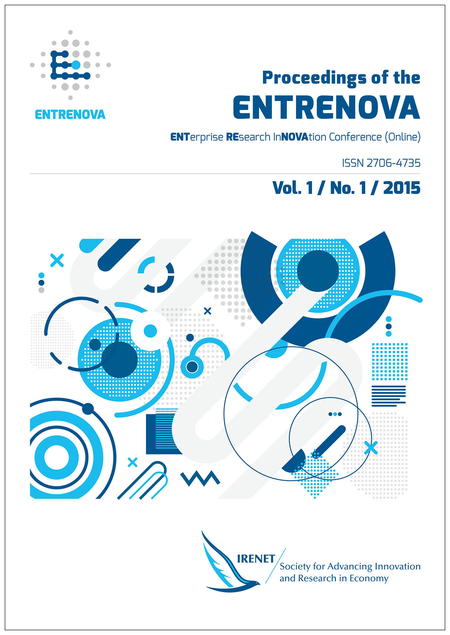Putting the Individual in Ambidexterity – Identifying Activities to Achieve Organisational Ambidexterity and Long-Term Survival
Keywords:
Organisational ambidexterity, Individual ambidexterity, Knowledge seeking, Knowledge offerAbstract
Vast research is dedicated to enable companies to exploit existing knowledge to optimize processes as well as to explore new ways to conduct business. In other words how to achieve organisational ambidexterity. Previous research focuses mainly on ambidexterity at organisational or business unit level. Only few papers provide answers for academics or practitioners, what specific individual activities have to be pursuit for ambidexterity. The aim of the paper is to mitigate this research gap by screening research on organisational ambidexterity and filter out findings concerning individual ambidexterity. Applying a systematic review approach, the paper reviews academic literature and identifies knowledge seeking and knowledge offer as the core activities of individual ambidexterity. Building on this, a review is conducted to identify the antecedents of knowledge seeking and offer. Finally, the antecedents are structured according to its relevance in the knowledge adoption process. Thus, the paper contributes to research by providing a state of the art, conceptual base for further investigations into the individual ambidexterity topic.

This work is licensed under a Creative Commons Attribution-NonCommercial 4.0 International License.
References
Bartels, J., Reinders, M. J. (2011), “Consumer innovativeness and its correlates: A propositional inventory for future research”, Journal of Business Research, Vol. 64 No. 6, pp. 601–609.
Birkinshaw, J., Gupta, K. (2013a), “Clarifying the Distinctive Contribution of Ambidexterity to the Field of Organization Studies”, The Academy of Management Perspectives, Vol. 27 No. 4, pp. 287–298.
Chandrasekaran, A., Linderman, K., Schroeder, R. (2012), “Antecedents to ambidexterity competency in high technology organizations”, Journal of Operations Management, Vol. 30 No. 1–2, pp. 134–151.
Denyer, D., Tranfield, D. (2009), “Producing a systematic review”, In D. A. Buchanan & A. Bryman (Hrsg.), The Sage handbook of organizational research methods (pp. 671–689). Thousand Oaks, CA: Sage Publications Ltd.
Ferreira, P., Raisch, S., Klarner, P. (2014), “Staying Agile in the Saddle: CEO Tenure, TMT Change, and Organizational Ambidexterity”, Academy of Management Proceedings, doi: 10.5465/AMBPP.2014.16112abstract
Gibson, C. B., Birkinshaw, J. (2004), “The Antecedents, Consequences, and Mediating Role of Organizational Ambidexterity”, Academy of Management Journal, Vol. 47 No. 2, pp. 209–226.
He, Z.-L., Wong, P.-K. (2004), “Exploration vs. Exploitation: An Empirical Test of the Ambidexterity Hypothesis”, Organization Science, Vol. 15 No. 4, pp. 481–494.
Jansen, J. J. P., Tempelaar, M. P., van den Bosch, F. A. J., Volberda, H. W. (2009), “Structural Differentiation and Ambidexterity: The Mediating Role of Integration Mechanisms”, Organization Science, Vol. 20 No. 4, pp. 797–811.
Kauppila, O.-P. (2010), “Creating ambidexterity by integrating and balancing structurally separate interorganizational partnerships”, Strategic Organization, Vol. 8 No. 4, pp. 283–312.
Kortmann, S. (2014), “The Mediating Role of Strategic Orientations on the Relationship between Ambidexterity - Oriented Decisions and Innovative Ambidexterity”, Journal of Product Innovation Management, Vol. 32 No. 5, pp. 666–684.
Lavie, D., Stettner, U., Tushman, M. L. (2010), “Exploration and Exploitation Within and Across Organizations”, The Academy of Management Annals, Vol. 4 No. 1, pp. 109–155.
Levinthal, D. A., March, J. G. (1993), “The Myopia of Learning”, Strategic Management Journal, Vol. 14 No. 2, pp. 95-112.
Lin, Z. (John), Yang, H., Demirkan, I. (2007), “The Performance Consequences of Ambidexterity in Strategic Alliance Formations: Empirical Investigation and Computational Theorizing, Management Science”, Vol. 53 No. 10, pp. 1645–1658.
Lubatkin, M. H., Simsek, Z., Ling, Y., Veiga, J. F. (2006), “Ambidexterity and Performance in Small-to Medium-Sized Firms: The Pivotal Role of TopManagement Team Behavioural Integration”, Journal of Management, Vol. 32 No. 5, pp. 646–672.
March, J. G. (1991), “Exploration and Exploitation in Organizational Learning”, Organization Science, Vol. 2 No. 1, pp. 71-87.
Mom, T. J. M., Van Den Bosch, F. A. J., Volberda, H. W. (2007), “Investigating Managers’ Exploration and Exploitation Activities: The Influence of Top-Down, Bottom-Up, and Horizontal Knowledge Inflows”, Journal of Management Studies, Vol. 44 No. 6, pp. 910–931.
Mom, T. J. M., van den Bosch, F. A. J., Volberda, H. W. (2009), “Understanding Variation in Managers’ Ambidexterity: Investigating Direct and Interaction Effects of Formal Structural and Personal Coordination Mechanisms”, Organization Science, Vol. 20 No. 4, pp. 812–828.
O’Reilly, C. A., Tushman, M. L. (2013), “Organizational Ambidexterity: Past, Present, and Future. The Academy of Management Perspectives”, Vol. 27 No. 4, pp. 324–338.
O’Reilly, C. A., Tushman, M. L. (1996), “Evolution and revolution: mastering the dynamics of innovation and change”, California Management Review, Vol. 38 No. 4, pp. 8–30.
Patel, P. C., Terjesen, S., Li, D. (2012), “Enhancing effects of manufacturing flexibility through operational absorptive capacity and operational ambidexterity”, Journal of Operations Management, Vol. 30 No. 3, pp. 201–220.
Raisch, S., Birkinshaw, J. (2008), “Organizational Ambidexterity: Antecedents, Outcomes, and Moderators”, Journal of Management, Vol. 34 No. 3, pp. 375-409.
Raisch, S., Birkinshaw, J., Probst, G., Tushman, M. L. (2009a), “Organizational Ambidexterity: Balancing Exploitation and Exploration for Sustained Performance”, Organization Science, Vol. 20 No. 4, pp. 685–695.
Raisch, S., Birkinshaw, J., Probst, G., Tushman, M. L. (2009b), “Organizational Ambidexterity: Balancing Exploitation and Exploration for Sustained Performance”, Organization Science, Vol. 20 No. 4, pp. 685–695.
Simsek, Z. (2009), “Organizational Ambidexterity: Towards a Multilevel Understanding”, Journal of Management Studies, Vol. 46 No. 4, pp. 597–624.
Talke, K., Heidenreich, S. (2014), “How to Overcome Pro-Change Bias: Incorporating Passive and Active Innovation Resistance in Innovation Decision Models”, Journal of Product Innovation Management, Vol. 31 No. 5, pp. 894–907.

